Effects of shed modifications on ewe reproductive performance and lamb growth rate in Inner Mongolia
X. Q. Zhang A , D. Kemp B , X. Y. Hou A C , C. M. Langford B , K. Wang A and W. H. Yan AA Grassland Research Institute, CAAS, Hohhot 010010, PR China.
B Charles Sturt University, Graham Centre, Orange, NSW 2800, Australia.
C Corresponding author. Email: houxy16@126.com
The Rangeland Journal 38(5) 479-487 https://doi.org/10.1071/RJ15127
Submitted: 25 December 2015 Accepted: 17 August 2016 Published: 22 September 2016
Journal Compilation © Australian Rangeland Society 2016
Abstract
The effects of warm sheds on the performance of ewes and their lambs in winter are poorly understood. The aim of the present study was to examine the effects of traditional sheds (TS + grazing) and modified warm sheds (WS, no grazing) on the reproductive performance of ewes (as well as their liveweight) and their lambs during the winter–spring period. Cross-bred ewes (n = 120) were randomly assigned to two treatments, either TS (+ grazing) or WS (no grazing), during the winter–spring period of 2011, 2012 and 2013. This study was conducted on two adjacent farms with the two treatments applied on each. The ewes in the TS treatment were grazed continuously on pasture in the day and housed in traditional sheds each evening, whereas the ewes in the WS treatment were not grazed. The animals in each treatment were fed the same amount of feed. Ewes housed in the WS group had a higher liveweight and lower weight loss than ewes in the TS group (P = 0.004 and 0.005 respectively); over the 3 years, the weight loss of the ewes in both groups was worst in the first 2 months (December–January) compared with the later 2 months, and was significantly alleviated after the first year (2011; P < 0.001). Lamb liveweight and gain were higher in the WS than TS treatment group (P < 0.001) and the growth rates of the lambs increased continuously as shed temperatures increased. Lamb weight gain and birthweight increased significantly with increasing years of the experiment (P < 0.001). There were more lambs born in the WS than in the TS groups (P = 0.020), with higher survival and twinning rates (P < 0.05). As shed temperatures increased, lambing, survival and twinning rates increased continuously. Therefore, keeping livestock in warm sheds during the winter and spring period will lift animal productivity, leading to improved household incomes. Elimination of winter grazing will reduce damage to already degraded grasslands and will assist herders to develop more positive attitudes towards animal production enterprises.
Additional keywords: cold stress, productivity, sheep, thermal time, warm shed.
Introduction
China’s 400 million ha of grasslands, 42% of China’s national land area, have become seriously degraded as a result of long-term overgrazing. The degradation of these grasslands creates ecological and social problems through reduced grassland and livestock productivity leading to decreased household incomes. Across northern and western China, there are 16 million people (Brown et al. 2008) directly dependent upon livestock for at least three-quarters of their incomes. These herders are among the poorest people in China, and another 30 million people are closely dependent upon these grasslands (Kemp and Michalk 2007). Grazing practices remain traditional, with long-established systems of livestock herders that focus on animal survival for much of the year with short periods of livestock growth over summer. Changing the current management strategy without reducing household incomes is an initial step towards improving the productivity of pastoral livestock systems and rehabilitating the grasslands.
The grassland regions across northern and western China have a short 3- to 4-month growing season over late spring and summer, when two-thirds of the annual precipitation falls, followed by dry and very cold periods from autumn through to early spring; temperatures often decline to −30°C or lower in winter (Zhao et al. 2010; Zheng et al. 2010b). Taipusi Banner (County) in Inner Mongolia is typical of this region and has a temperate semi-arid continental climate with a mean annual precipitation of 300–350 mm and a yearly average temperature of 2°C. Daily air temperatures are often below −20°C in winter; in the coldest period (January–February) in the middle of lambing it can be −40°C at night (Wang 2000). Rainfall primarily occurs between June and August, the main growth period of the native vegetation. Late August to September rainfall is more reliable but less important for plant growth. Seasonal droughts occur in spring and autumn, and less frequently in summer. The frost-free period is 115 days from May through September. Grassland in good condition is dominated by Stipa krylovii Roshev. and Leymus chinensis (Trin.) Tzvel., but the native vegetation has been seriously degraded. On overgrazed areas, the undesirable species Stellera chamaejasme Linn. and Convolvulus ammannii Desr. become dominant (Shan et al. 2008).
Short-tail cross-bred sheep are the major source of income for local herders. These sheep typically produce 3–4 kg coarse low-value wool, have a mature liveweight of 35–50 kg and generally produce one lamb per ewe each year. Lambing time ranges from December through to April, and the lambs are usually sold in September. In the region, sheep are traditionally grazed all year, but grasslands can only maintain or increase liveweights through summer (Zheng et al. 2011). Traditionally, no feed supplementation is given in summer and only a small quantity of maize and/or oats is provided during winter–spring, typically at a sub-maintenance rate.
In winter, herders traditionally take livestock out to graze daily and the livestock are housed in shelters or sheds each evening. The pregnant ewes are exposed to cold stress that causes body temperature to fall, with a consequent fall in fetal body temperature (Laburn et al. 2002; Faurie et al. 2004). The sheds used traditionally provide shelter from winds and storms, but the temperatures inside are not greatly different to ambient temperatures outside the sheds, rarely exceeding −5°C through winter. New ‘glasshouse’ or ‘greenhouse’ sheds with minimal air gaps, some including a heater, are able to maintain an inside temperature in January of 5°C during the day and above 1°C at night (Huang et al. 1995). This reduces the energy requitement of animals, which reduces weight loss (Wang et al. 2012). However, new sheds are expensive and herders cannot afford them without significant government subsidies. An alternative strategy is to modify the existing sheds by filling air gaps and using heaters, in combination with no grazing and better feeding strategies throughout the winter. Previous studies have focused on animal liveweight changes, but little is known about reproductive performance because lambing traditionally occurs in mid-winter, when animals are often in a very poor physiological state.
The aim of the present 3-year study was to investigate the effects of traditional sheds (TS + grazing) and modified ‘warm’ sheds (WS, no grazing) on the reproduction performance of ewes and the changes in liveweight of the ewes and their lambs during winter–spring.
Materials and methods
Study site
The experiment was conducted on two adjacent farms in Taipusi Banner (115°50ʹE, 42°30ʹN), Inner Mongolia, in China, from December to April in 2011, 2012 and 2013.
Animals and management
Local 2- to 5-year-old ewes from local herders, weighing, on average, 43 kg, were used in the present study from 2011 to 2013. The animals were randomly assigned to two treatment groups (n = 60 sheep in each), either TS + grazing or the WS and no grazing, on each farm. Ewes remained in the same treatment group over the years. A total of 5% replacements from the same sources were needed due to losses. The 120 ewes were mated as one group over summer to three Ujumqin rams. In summer and early autumn, all ewes were grazed on available grassland during the day and returned to the traditional sheds in the evening. During winter and spring, the ewes in the TS + grazing groups were grazed continuously each day and housed in the traditional sheds each evening, where the average daytime and night temperatures were –3.6 and –4.8°C respectively over the experiment period. The ewes in the WS group were housed in the warm sheds each day and allowed access to a nearby walled yard through the middle of the day (Fig. 1). Average daytime and night temperatures inside the warm sheds were –1.4 and 0.8°C respectively.
All animals in each group were fed the same amount of ground maize, naked oats, distillers’ grain and grass hay. Maize, oats and distillers’ grain were fed twice daily at 0800 and 1830 hours, with pregnant ewes receiving 250, 0 and 0 g day–1 respectively, compared with 250, 250, and 500 g day–1 respectively for lactating ewes. Dried grass hay was fed at a rate of 1.5 kg ewe–1 day–1 throughout, with a refusal rate of 15%. Commercial concentrate was offered to lambs (fed separately) from 1 week of age (common practice) and was adjusted daily on the basis of the previous day’s intake, up to a maximum of 200 g day–1. The nutritive value of each supplement is given in Table 1. Water and salt licks were available ad libitum throughout the experimental period. All ewes were weighed once a month at 0800 hours before feeding or grazing; the bodyweight of lambs was measured at the same time.
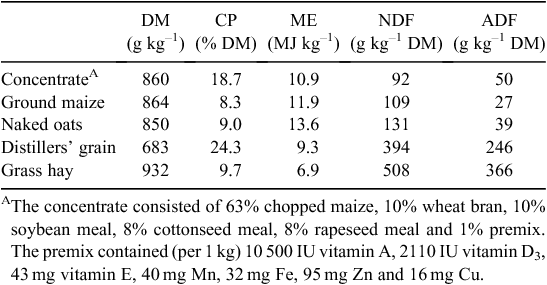
|
Shed structure and condition
Sheep were housed separately in individual sheds for each treatment. The traditional sheds (on the left of the yard in Fig. 1) had walls all around, but with significant openings at the main entrance and nearby sides. The rear roof was tiled and the front was covered with hay. The floor area of this shed was 50 m2 for the 60 sheep that were penned at night. The warm shed (on the right of the yard in Fig. 1) was a modified shed that had four side walls and an inclined roof covered with tiles. Gaps were filled to minimise airflow. The two windows on the front wall could be opened when appropriate to improve airflow. The floor area of this shed was 48 m2. A thermostat-controlled small electrical heater was installed, attached to the centre of the roof beam of the shed. This heater was operated manually when inside temperatures fell below −5°C at night and was turned off when night-time temperatures were above 0°C. Supplements were fed in three iron troughs outside each shed.
Shed temperature recording
Temperatures in the traditional and warm sheds were recorded hourly using a recorder (YBJL-890, Qingdao Jiaqi Electronic Equipment Co., Ltd., China). Each recorder was located in the middle of each roof beam.
Data analyses
Monthly changes in animal growth performance in each treatment during the period from December to April over the 3 years were analysed using repeated measures in the MIXED procedure (SAS Institute 2000) with a model that included fixed and interactive effects of treatment, month and year, whereas the individual sheep were considered as random factors. When this model was used to analyse the birthweight of lambs, lambing month was considered as a random effect. When the factors were significant (P < 0.05), means were compared using Tukey’s test. Animal reproductive performance over a year was also analysed using the MIXED procedure; if the P-value was significant, a two-sample t-test for means was performed to examine the difference between treatments. Differences were considered significant at two-tailed P ≤ 0.05. Thermal time (degree-days) was calculated as the sum of average daily temperature × days over a month; in effect, this is cooling degree-days. Linear regression analysis was used to evaluate the relationship between air temperature or thermal time and liveweight loss or gain. The relationship between air temperature or thermal time and reproductive performance of animals was further evaluated by linear regression. Multiple stepwise regression was used to investigate the correlation between weight loss or gain and shed air temperature or thermal time in the different years and months (December–April).
Results
Changes in the growth performance of ewes and lambs
The liveweight and weight loss of ewes were significantly affected by treatment, year and month, and there were interactive effects among them. Ewes kept in the warm sheds had a higher liveweight and a lower weight loss than those kept in the traditional sheds (+1.6 kg head–1 (P = 0.004) and –22 g head–1 day–1 (P = 0.006) respectively; Table 2); over the 3 years, as the season progressed from December to April, the liveweights decreased continuously from 51 to 36 kg (P < 0.001), and those losses were worst in the first 2 months (December–January) compared with the later 2 months. The liveweight of the ewes was higher in both 2012 and 2013 than in 2011 (42.9 and 43.5 vs 40.3 kg respectively; P < 0.001). Consequently, those losses in the later 2 years were less (P < 0.001). Ewe weights decreased, on average, by 9.9 g day–1 for each 1°C decrease in air temperature, or 45 g day–1 for each 100 degree-days decrease in (cooling) thermal time (Fig. 2a, b). Lamb growth rates increased with increased temperature and thermal time (Fig. 3a, b). For a 1°C rise in air temperature, lamb growth rates increased by 6.3 g day–1, whereas for an increase of 100 degree-days, the increased lamb growth rate was 26 g day–1. There was an interesting effect of time, with much lower lamb growth rates in December. This could reflect the fact that fewer and smaller lambs were born that month, with bigger lambs born in later months. There was a significant difference in terms of liveweight and weight gain of lambs between treatments; both parameters were higher in for lambs in the WS group (11.8 kg head–1 and 182 g head–1 day–1 respectively) than for those in the TS group (10.8 kg head–1 and 163 g head–1 day–1 respectively; P = 0.0001 and P = 0.0005; Tables 2, 3). The growth rate increased continuously as the shed air temperature or thermal time increased (Fig. 3a, b). Birthweight was unaffected by shed type, ranging from 3.9 to 4.0 kg (Tables 2, 3), whereas it was affected by year (P < 0.001; Table 3). Birthweight, liveweight and the weight gain of lambs were significantly heavier in the latter 2 years than in the first year.
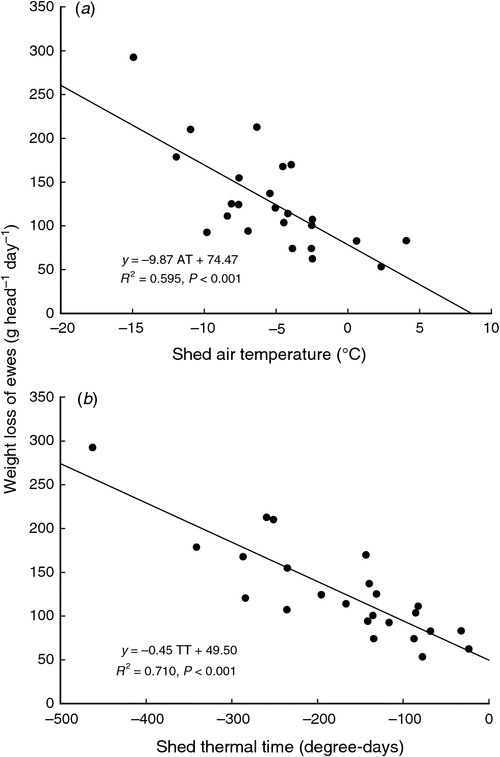
|
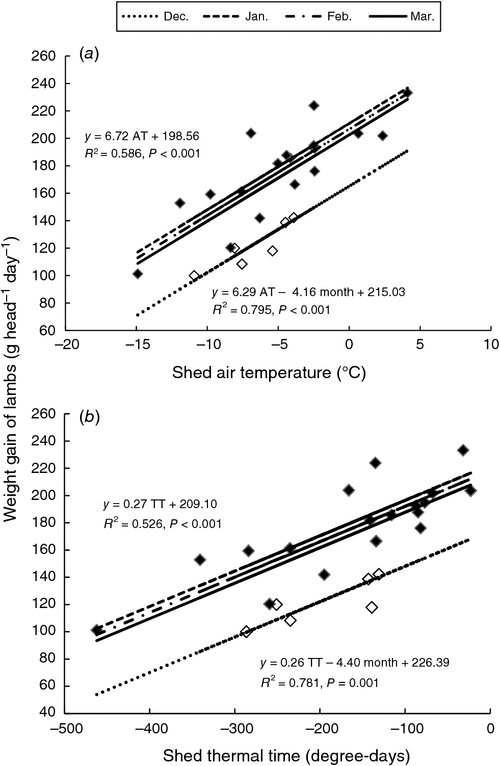
|
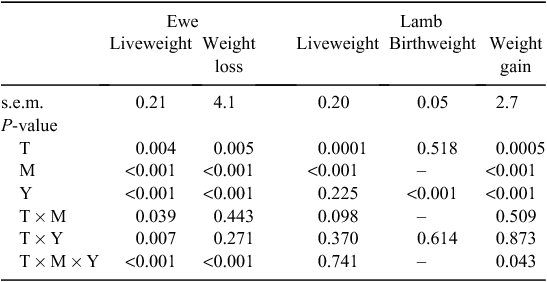
|
Changes in the reproductive performance of ewes
The number of lambs born in December–January over the 3 years was greater in the WS than TS groups (P = 0.050; Fig. 4a), with the annual average number of lambs born in warm sheds consistently greater than that born in traditional sheds (62 vs 60 head year–1; P = 0.020). In the first year, the ewes housed in the warm sheds had a similar total number of lambs to ewes housed in the traditional sheds, but in the last 2 years ewes in the WS group had more lambs than those in the TS group (62 and 63 vs 59 and 60 head year–1). Twinning rate for WS ewes increased from 2% in 2011 to 5% in 2012 and to 7% in 2013 (P = 0.018; Fig. 4b, d, f). The WS ewes had a higher lamb survival rate in 2011, 2012 and 2013 (98%, 100% and 100%) and a higher lambing rate (103%, 104% and 104%), compared with TS ewes (survival rates 95%, 96% and 95%; P = 0.004) and lambing rates 98%, 98% and 98%; P = 0.011), respectively). As the shed air temperature or thermal time increased, lambing, survival and twinning rates increased (Figs 5, 6).
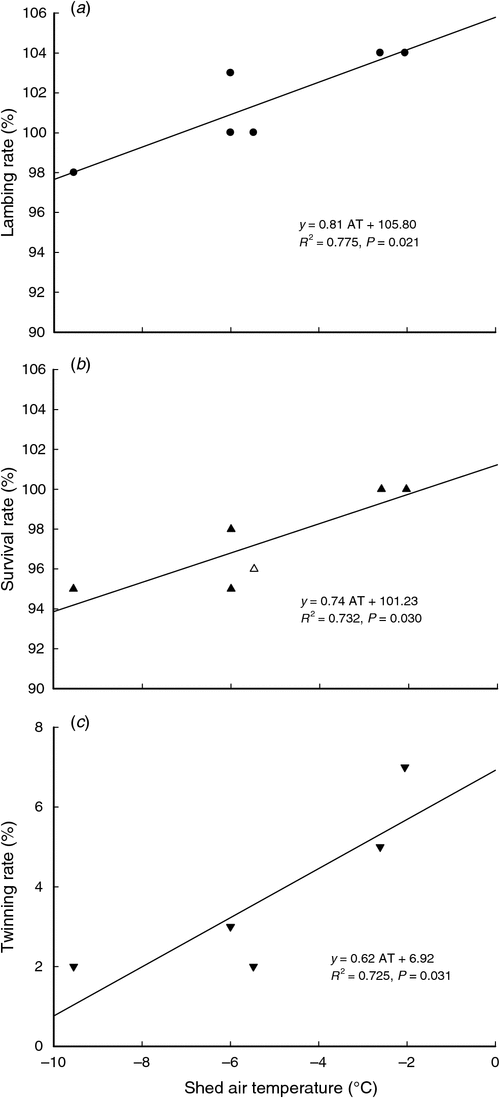
|
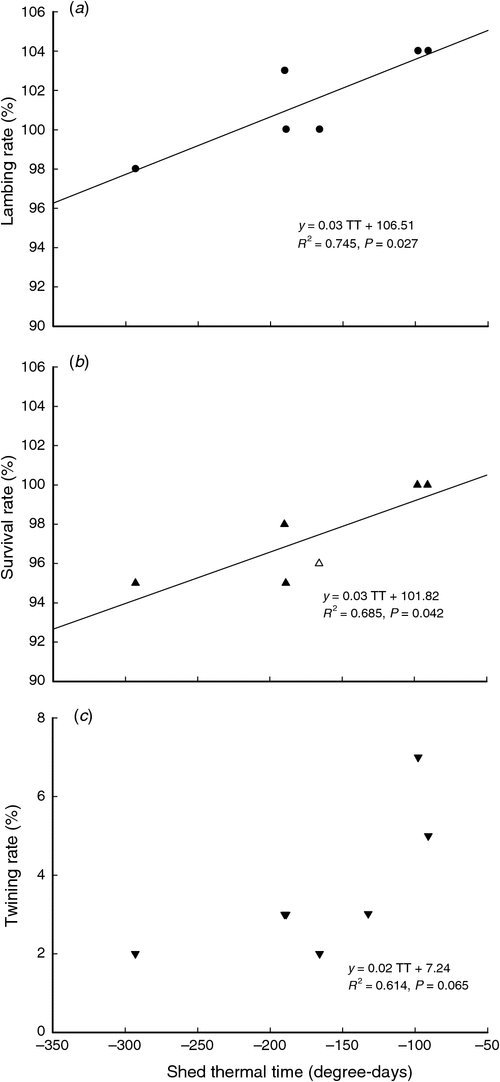
|
Discussion
Effects of different sheds on sheep liveweight
Low winter temperatures have severe effects on the energy requirements of livestock. For adult sheep, with reasonable wool coverage (2 cm), the lower critical temperature is −3°C, below which the energy requirements increase significantly (Freer et al. 2007). Zhang et al. (2010) reported that the daily heat loss for sheep has been estimated to be 9–17 MJ day–1 during winter when the average temperature is below −5°C (i.e. approaching twice the energy requirement of these animals in mild conditions). In the case of Taipusi Banner, where winter temperatures and wind chill factors result in high energy demands, the animals will lose weight. During the entire experimental period, the average temperature outside in winter–spring was –8.2°C, well below the range reported by Freer et al. (2007). Such lower temperatures in winter mean that considerable amounts of energy from high-quality supplements would be needed by ewes to prevent any weight loss and maintain pregnancy and lambing. However, as pointed out by Wang et al. (2012), the metabolisable energy requirement for maintenance of sheep kept in a warm shed was 2–4 MJ day–1 head–1 lower than for those in a traditional shed during winter, or grazed all year. In addition, ewes grazing low-quality forage in winter temperatures consume insufficient energy to maintain body temperature and liveweight in pregnancy, resulting in significant weight loss over the protracted winter, even when housed in traditional livestock sheds where the inside temperature is often below −10°C (Huang et al. 1995). The results reported by Zheng et al. (2010a) demonstrate that an imbalance between energy supply and demand is the major reason for the weight loss seen in animals between October and May in Taipusi Banner. However housing animals in a modified warm shed can reduce weight loss. In the present study, ewes allocated to the warm sheds maintained significant higher liveweight and reduced weight loss by 19% (22 g head–1 day–1) compared with ewes kept in traditional sheds, whereas lamb weight gains increased by 12% (19 g head–1 day–1; Table 2). This was due to the warm sheds retaining greater amounts of warmth within and being more resistant to heat loss. It is important to note that animals will still lose weight slowly even if kept under mild conditions on poor-quality forage, typical of the conditions that apply in the study environment (Zheng et al. 2010b; Gu et al. 2015). The benefits of the warm sheds would also be related to the reduced walking and grazing activity of the sheep, as well as reduced exposure to wind chill. These physical activities can account for 25–50% of daily energy requirements by grazing ruminants and the additional energy expenditure for these activities can reduce productivity (Osuji 1974; Animut et al. 2005). This was likely to be the main reason for the difference in liveweight of ewes after the first year feeding in warm sheds. Considering this together with the results from linear regression analysis, we can conclude that the reduction of cold sum and extra energy expenditure through warm shed feeding during winter–spring is an efficient way to minimise liveweight loss caused by cold stress. Ewes that are managed traditionally graze in winter and are exposed to cold temperatures and wind chill, in addition to their energy requirements due to walking and low forage quality (Zhang et al. 2014). Therefore, local herders should focus more on housing sheep in a warm shed and feeding animals rather than grazing during cold seasons, which could decrease the weight loss of ewes by 19% and increase the weight gain of lambs by 12%.
In addition, keeping ewes in a warm shed in winter, particularly during the coldest parts of the year, will reduce weight loss due to cold stress and supply better nutrition during pregnancy for ewes, consequently resulting in higher growth rates of their lambs. This can be further demonstrated through the linear relationships between the weight gain of lambs and air temperature and thermal time (Fig. 3). The higher growth rate of WS lambs, in combination with increased feeding, will result in higher initial weights when summer grazing begins. These lambs can then be marketed earlier, meaning fewer animals grazing before winter and also possibly higher-quality products. As found by Tuo et al. (2016), yaks (6–8 years of age) fed in a warm shed had a higher liveweight compared with yaks grazing (+283 g head–1 day–1), and the daily weight gain of the WS yaks calves was higher by 189 g head–1 day–1 compared with calves from grazing yaks. Similar findings were observed for WS yaks by Chen (2012). Nevertheless, in the present study, the effect of warm sheds on ewe liveweight was significant but limited, and the growth rate of lambs (182 g head–1 day–1) was below that of well-fed lambs under mild conditions (200 g head–1 day–1 for housed 0.5-year-old castrated Dorset lambs; Freer et al. 2007), regardless of genetic differences. This implies that modifying existing sheds is not the best solution. It may be that some more marked modifications are needed, such as building a glass roof on the southern part of the shed, using better insulation, allowing good airflow and establishing different procedures for when animals are allowed outside the shed.
Effects of different sheds on the reproductive performance of ewes
Under natural grazing conditions, traditional simple shed and whole-year grazing with a small supplementation in winter, the weight of adult ewes ranged from 35 to 50 kg head–1 and that of lambs or kids ranged from 15 to 20 kg head–1, with a survival rate of young animals of 95–99% (Zheng et al. 2011); twins are rare. Lambing rates can be 90%, because mating occurs when animals are in peak condition at the end of summer. Survival rates are typically high because the herders keep lambs in shelters all day, provide some supplements from 7–10 days of age and try to avoid stressing the lambs. In the present study, all rams were better fed than normally applies and the same rams were used with all the ewes to avoid any effect on fecundity. These practices are probably why there was no effect of sheds on lamb birthweight, although the few twin lambs born in the warm sheds did have higher weights than may have been expected and, as a consequence, better survival. The warm sheds did result in lambing rates exceeding 100% (Fig. 4b, d, f) and better reproductive performance of ewes. This is due primarily to the warm sheds reducing heat loss around lambing time. It is evident that there were significant positive relationships between the reproductive performance of ewes and annual average temperature in December–April. This finding is consistent with the results reported by Gong et al. (2011) and Deng et al. (2010) over a 2-year experimental period. All the changes found herein suggest that warm sheds could be used to improve the productivity of ewes. In addition, feeding in warm sheds can be accommodated within the reduced household workforce. Applied over a few years, this should be sufficient to enable herders to increase their incomes from their animals. From the above results, it is important for herders to change their current grazing practices to feeding in standard warm sheds or greenhouses during the winter–spring period.
Conclusions
Housing livestock in warm sheds, in combination with feeding a moderate quantity of fodder, is a more efficient management strategy that will enhance the reproductive performance of ewes and the growth performance of lambs, leading to increased household incomes. Most importantly, housing in warm sheds will reduce the number of animals causing damage to the degraded grasslands during the cold season. However, the modifications made to sheds in the present study meant that the gain in lambs (1.2 extra lambs at US$98 head–1) was only equal to the cost of electricity for the heater (US$113 year–1). More efficient designs need to be sought that can achieve better economic outcomes.
Acknowledgements
The work reported herein was funded by the Australia Centre for International Agriculture Research (ACIAR), the National Key Basic Research Program of China (2014CB138805) and the National Natural Science Foundation (31402119). The authors thank Ma Yu-bao and Jiang Chao for their support.
References
Animut, G., Goetsch, A. L., Aiken, G. E., Puchala, R., Detweiler, G., Krehbiel, C. R., Merkel, R. C., Sahlu, T., Dawson, L. J., Johnson, Z. B., and Gipson, T. A. (2005). Grazing behavior and energy expenditure by sheep and goats co-grazing grass/forb pastures at three stocking rates. Small Ruminant Research 59, 191–201.| Grazing behavior and energy expenditure by sheep and goats co-grazing grass/forb pastures at three stocking rates.Crossref | GoogleScholarGoogle Scholar |
Brown, C. G., Waldron, S. A., and Longworth, J. W. (2008). ‘Sustainable Development in Western China: Managing People, Livestock and Grasslands in Pastoral Areas.’ (Edward Elgar Publishing: Cheltenham, UK.)
Chen, W. Q. (2012). Effect of feed supplement on grazing yaks housed in warm-shelter. Chinese Qinghai Journal of Animal and Veterinary Sciences 42, 22–23.
Deng, Y. Y., Yu, X. F., Jiang, M. S., Chen, G. X., and Chen, X. Q. (2010). Study on the relationship between temperature–humidity and the reproductive competence of ewes. China Animal Husbandry and Veterinary Medicine 37, 249–252.
Faurie, A. S., Mitchell, D., and Laburn, H. P. (2004). Peripartum body temperatures in free-ranging ewes (Ovis aries) and their lambs. Journal of Thermal Biology 29, 115–122.
| Peripartum body temperatures in free-ranging ewes (Ovis aries) and their lambs.Crossref | GoogleScholarGoogle Scholar |
Freer, M., Dove, H., and Nolan, J. V. (2007). ‘Nutrient Requirements of Domesticated Ruminants.’ (CSIRO Publishing: Melbourne, Vic.)
Gong, X. Y., Wu, J. P., Zhang, L. P., Yang, L., Feng, M. T., Zhao, H. J., and Du, X. L. (2011). Influence of feeding patterns on production efficiency of sheep in the cold season. Pratacultural Science 28, 141–145.
Gu, Y., Sedandamba, , Yao, J. Y., Mandoula, , Langteng, , Xu, Z. L., Wang, W., and Zheng, J. F. (2015). Influence of warm shed feeding manner on weight and wool production performance of Ordos fine wool sheep in cold season. Animal Husbandry and Feed Science 36, 25–27.
Huang, G. Q., Li, Y. F., Zhang, S. W., Tian, Y., Wang, J. L., and Wang, Y. J. (1995). The experimental study on the solar oxshed. Transactions of the Chinese Society of Agricultural Engineering 11, 114–119.
Kemp, D. R., and Michalk, D. L. (2007). Towards sustainable grassland and livestock management. Journal of Agricultural Science, Cambridge 145, 543–564.
| Towards sustainable grassland and livestock management.Crossref | GoogleScholarGoogle Scholar |
Laburn, H. P., Faurie, A., Goelst, K., and Mitchell, D. (2002). Effects on foetal and maternal body temperatures of exposure of pregnant ewes to heat, cold, and exercise. Journal of Applied Physiology 92, 802–808.
| Effects on foetal and maternal body temperatures of exposure of pregnant ewes to heat, cold, and exercise.Crossref | GoogleScholarGoogle Scholar | 11796695PubMed |
Osuji, P. O. (1974). The physiology of eating and energy expenditure of ruminant at pasture. Journal of Range Management 27, 437–443.
| The physiology of eating and energy expenditure of ruminant at pasture.Crossref | GoogleScholarGoogle Scholar |
SAS Institute (2000). ‘SAS/STAT User’s Guide: Version 8.’ 1st edn. (SAS Institute Inc.: Cary, NC.)
Shan, G. L., Xu, Z., Ning, F., Ma, Y. B., and Li, L. H. (2008). Influence of exclosure year on community structure and species diversity on atypical steppe. Acta Prataculturae Sinica 17, 1–8.
Tuo, S. Z., Bao, S. K., and Hua, Z. (2016). Study on the key efficient strategy for raising yak. Heilongjiang Animal Science and Veterinary Medicine 2, 204–208.
Wang, H. L. (2000). ‘Taipusi Chronicles.’ (Inner Mongolia Culture Press: Hailar, China.) [in Chinese]
Wang, X. J., Bai, Z. Q., Yang, L., Cao, D. M., Zhang, K., Gong, X. Y., and Zhang, A. H. (2012). Effects of pen-fed on farmers’ income and sheep production in cold season in semi agricultural and semi pastoral area in Wushaoling. Pratacultural Science 29, 478–481.
Zhang, S. Y., Han, G. D., Zhao, M. L., Li, Z. G., Chaoketu, , and Wuritu, (2010). Effect of greenhouse feeding on weight gain of Ujumuqin sheep based on the typical model in Inner Mongolia in winter. Animal Husbandry and Feed Science 31, 45–47.
Zhang, X. Q., Luo, H. L., Hou, X. Y., Badgery, W. B., Zhang, Y. J., and Jiang, C. (2014). Effect of restricted access to pasture and indoor supplementation on ingestive behaviour, dry matter intake and weight gain of growing lambs. Livestock Science 167, 137–143.
| Effect of restricted access to pasture and indoor supplementation on ingestive behaviour, dry matter intake and weight gain of growing lambs.Crossref | GoogleScholarGoogle Scholar |
Zhao, H. J., Yang, L., Feng, M. T., Ma, Z. F., Yang, S. W., Hua, L. M., Gong, X. Y., and Wu, J. P. (2010). Comparison of feeding effect on Gansu alpine fine wool sheep between grazing and greenhouse feeding during withered season. Pratacultural Science 27, 117–121.
Zheng, Y., Xu, Z., Hao, F., Ma, Y. B., and Li, L. H. (2010a). Benefit analysis on greenhouse sheep breeding of typical steppe in Inner Mongolia. Journal of Domestic Animal Ecology 31, 64–69.
Zheng, Y., Xu, Z., Kemp, D., Takahashi, T., and Jones, R. (2010b). Modeling optimal grazing management for grassland rehabilitation on the typical steppe: a case study in Taipusi Banner, Inner Mongolia, China. Philippine Agricultural Scientist 93, 369–377.
Zheng, Y., Xu, Z., Kemp, D., Shan, G. L., Tian, Q. S., and Xie, J. H. (2011). Public grazing systems on typical steppe grasslands in Taipusi Banner, Inner Mongolia Autonomous Region. In ‘Development of Sustainable Livestock Systems on Grasslands in North-western China’. (Eds D. R. Kemp and D. L. Michalk.) pp. 58–68. (Australian Centre for International Agricultural Research: Canberra, ACT.)





